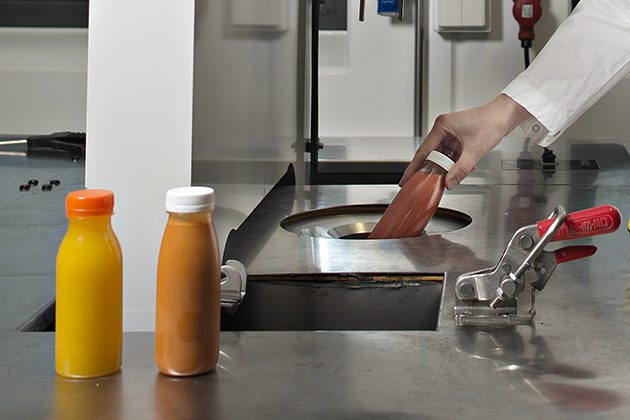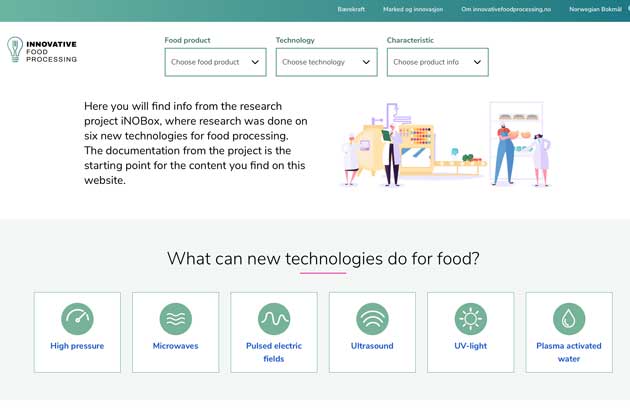Worth knowing about high pressure processing of food

Exposing food products and raw materials to high pressure can be effective in inactivating bacteria. The method is gentle on the food products and the processing can be done at room temperature or lower temperatures. Nutrients and other properties can thus be retained better than when using alternative processing methods.
Content
Why high pressure?
High pressure processing (HPP) is a technology that can be used for gentle industrial processing of food. HPP is increasingly used to preserve food products and is suitable for both liquid and solid products. The process is well suited for heat-sensitive products and products with low pH. HPP is mainly used to extend the shelf life of food products, and/or to inactivate microorganisms. HPP is also used to preserve a variety of different products, such as juices, ready meals, salads, meat toppings, purees and pastes.
High pressure processing of food can be used to give food products
- longer shelf life (guacamole, ready meals, juice)
- increased food safety (salami, meat toppings, smoked salmon and chicken)
- improved quality (texture in sauces, soups and yoghurt)
- healthier and fresher foods (preserves nutrients well)
- increased resource utilisation (easier processing and increased yield from mussels and other shellfish)
HPP is primarily used to extend shelf life and/or inactivate pathogenic microorganisms. HPP is often used on a range of products sold as high-quality products where precisely the application of this gentle processing method is used as a sales argument. The focus is then on food safety and on the products being pure, natural (no additives) and healthy.
How high pressure processing of food takes place
The food product must be pre-packaged and is placed in a container filled with water. The largest machines have chambers with a capacity of over 600 litres. When the machine is full, even more water is pressed in, creating the high pressure.
If the purpose is to achieve pasteurisation conditions, the processing usually occurs at 400-600 MPa (megapascals) with a holding time of 1-5 minutes. With this type of processing, the whole product is exposed to an even pressure, regardless of shape and size.
As extreme pressure is applied in a closed system, the high pressure increase also causes the temperature in the product to rise. The temperature generally increases by about 3°C per 100 MPa, but if the product contains large amounts of fat, the increase can reach 7-9°C per 100 MPa. After processing, the temperature of the product quickly decreases.
Find out more: How does high pressure processing work?
Watch video
This short animated film shows how high processing works and what it can do for food.
Also check out this article:
How does high pressure processing work?
from the website innovativefoodprocessing.no.
Applications in food industry
HPP has several applications in food production.
A great advantage is that the size and geometry of the food product are of no significance, unlike in, for example, heat treatment. In fact, the pressure load in HPP occurs immediately throughout the product regardless of size and geometry. This is beneficial to, for example, upscaling processes.
The efficacy of HPP in inactivating vegetative bacteria has been well documented. In most cases, food producers that use HPP want an alternative to other types of preservation. Many producers profile their products as pure and without the use of preservatives. Therefore, products treated with HPP are often characterised by minimal use of preservatives. There are also examples where the actual high pressure process can contribute to an adjustment of product formulas and, for example, result in the use of less salt or added sweetener in products.
Various packing material can be used, but one prerequisite is that the packaging is flexible and can withstand water.
More details on packaging for high pressure processing
Food preservation
HPP can inactivate both spoilage and pathogenic bacteria (but not spores or enzymes) in foods, with no or low impact on sensory and nutritional properties.
What food products can be processed using high pressure?
High pressure processing can be applied to many different food products. This type of processing is particularly well suited for liquid products such as juices, soups, sauces, purees and pastes, but also a number of meat products are well suited for HPP. However, some food products that have a very low water activity (e.g. dry products) and air-containing products are not suitable for HPP.
Beverages
HPP can be used for pasteurisation to prolong the shelf life of liquid foods, especially products with a low pH where spores cannot grow. This means that one of the most relevant applications for HPP is pasteurisation of fruit juice.
Fruit, berry and vegetable juices contain a number of enzymes which are affected by high pressure to varying degrees. The effect of high pressure processing on enzymes is an extensive field that we will not discuss in further detail here, but a general characteristic is that not all enzymes are inactivated through the application of pressure, unlike pasteurisation where heat is used. This often results in juice products that have been exposed to high pressure having a sediment, which means that the bottle needs to be shaken before use.
There are a number of commercial juices, smoothies and vegetable beverages. There are also several examples of products in these categories in Norway.
Meat products
In addition to beverages, there are a number of other products where HPP is used to prolong shelf life and ensure food safety. Meat products have been shown to be well suited for HPP. Cooked meat toppings, ready meals and cured meats are product types for which high pressure is widely used.
HPP can provide several benefits for meat products. The focus is often on prolonged shelf life and increased food safety. In addition, cross-contamination can be disregarded when this technology is applied, as HPP is used on packaged products. HPP can be used for both vacuum-packed and modified atmosphere-packed (MAP) products.
If HPP is used during processing, it can make it easier to export products to, for example, the United States and Japan. HPP is primarily used for pre-treated or pre-processed meat products. If a raw meat product is to be processed using high pressure, the product is usually in a marinade.
Dairy products
HPP is used to prolong the shelf life of probiotic and prebiotic products containing healthy lactic acid bacteria and/or components that are sensitive to, for example, heat (colostrum products). HPP is currently used primarily to increase the quality and prolong the shelf life of fresh cheese products, processed cheese snacks (sticks) and yogurt dressings.
It has also been shown that HPP can provide texture changes to yoghurt, and tests have been done with use of HPP for ripening of cheese.
Seafood products
Fish and other seafood products generally have a short shelf life due to their high water content, neutral pH and a variety of autolytic enzymes. There are several examples of HPP being used to prolong the shelf life of seafood products. High pressure processing can be applied to fresh oysters to achieve two benefits: Vibrio is inactivated and, in addition, the closing muscle is inactivated so that the shell can easily be opened.
Texture change on products
High pressure processing can be used to tenderise meat, but preferably at lower pressures such as around 200 MPa. A fair amount of research has been conducted on calpains and other proteases, and how these are affected by high pressure. To achieve a meat tenderisation effect, pre-rigor pressure processing should preferably be used. The meat tenderisation effect has been shown to be directly related to the degree of contraction achieved during the processing. Use of HPP during the pre-rigorperiod may be challenging as it requires ‘hot-boning’ and pressure processing of the meat while the pH is still high.
High pressure processing of milk for use in low-fat yoghurt production has shown that this type of yoghurt may acquire a viscosity similar to that of regular yoghurt.
Extraction of desired components
High pressure can be used as a pre-processing step in various extraction processes. Traditional extraction often requires solvents, may be time-consuming processes and often have varying yields. In a number of cases, use of high pressure as part of an extraction process may result in a quicker process, in a higher yield and in the avoidance of use of solvents.
In the literature, HPE (high pressure extraction) or HHPE (high hydrostatic pressure extraction) is often used when high pressure processing is applied in extraction processes.
Criteria for food products to be treated with high pressure processing
- Must not contain air or have internal air pockets (whole strawberries and marshmallows are, for example, not suitable).
- Must have a certain amount of water: dry products can be a challenge, as sufficient moisture is often needed to inactivate microorganisms effectively using HPP.
- Products with low acid content (high or neutral pH) must be stored under refrigerated conditions after HPP due to the risk of growth from spores. HPP in combination with other processes, such as heat, can also kill spores.
Pros of HPP
- The pressure is applied momentarily to the whole product regardless of geometry and size
- Possible to process food at room temperature.
- Can be combined with, for example, high and low temperature.
- Inactivates bacteria throughout the product.
- Provides high preservation of nutrients.
- Opportunities for new types of products, as the process can result in changes in product properties.
- Reduced energy consumption relative to conventional preservation methods.
- Avoidance of cross-contamination as HPP is used on packaged products.
- As HPP is a recognised processing method, it can simplify export procedures for some products.
Cons of HPP
- Different products have varying suitability for preservation with use of high pressure.
- The food must be packed in flexible packaging, i.e. not glass or metal (tin can).
- Processing at the highest pressures may result in changes in colour and/or texture for some product groups.
- HPP alone does not kill bacterial spores.
Combination processing with high pressure
HPP can be combined with several technologies. There are examples where HPP is used to kill a large number of bacteria in a raw material to be used in a process. A number of pre-processing steps can also be used to improve the effect of HPP.
Research has shown that better exploitation of the potential of HPP can be achieved by combining it with other processing methods to make the food products safer and/or increase their shelf life. Some examples are:
- Multi-step HPP. For spore inactivation, it has been observed that a two-step heat treatment in which one temperature is used to activate the spores, that is to trigger them into starting the process of entering into a vegetative life cycle, followed by a higher temperature in the next step to kill the bacteria. This can also achieve by running HPP over several steps.
- HPP and low temperature. HPP at lower temperatures can be beneficial in avoiding unnecessary temperature increases in the food product.
- HPP and heat. The efficacy of HPP in inactivating vegetative bacteria alone has been well documented. But if effective inactivation of spores is to be achieved, combination with heat treatment may be a possibility. This will require preheating of the products before they are placed in the HPP machine.
- HPP and antimicrobial components. By adding preservatives or antimicrobial components (such as nisin, organic acids and essential oils), an extended shelf life of products can be achieved.
- HPP and packing method. Food is usually packaged in bottles or vacuum-packed. But there is an option of combining this with, for example, modified atmosphere packaging.
- HPP and freezing/defrosting. Phase transitions to water are affected by pressure. This phenomenon makes it possible, for example, to defrost products at low temperatures (between -20 and 0 degrees C)
- HPP and other technology. Products can be pre-processed with another technology before being exposed to HPP in the final stage as the last processing step.
Brief history
Already in the late 19th century, high pressure was used to kill bacteria. The American Bert Hite (1899) was the first to use high pressure on food to pasteurize milk, fruits and vegetables. Even though some research was conducted into pressure and bacterial spores in the 1960s and 1970s, research into high pressure and food did not really take off until in the 1980s.
The first commercial products, produced by Meidy-ya, became available in Japan in 1991. Internationally, the technology is growing rapidly. Interest in high pressure processed food is increasing heavily, and equipment for high pressure processing is now available in a number of countries worldwide.

Learn more about high pressure and other processing technologies
As part of the research project “iNOBox” we have made information and documentation about several food processing technologies available here:
Contact person
Topics
High pressure processing
